The Tooth – Joint Connection
Imagine Waking up on a nice beautiful warm summer day to a searing pain in your mouth, only to discover this it’s not just your tooth screaming in echoing pain but your head banging and screeching in a numbing pain as well. You then pace back and forth in the hallway begging for your mouth and head to stop but, the vibrations causing a quite extravagancy pain is far to much. One might say this is a complex dance gone wrong and causing an immense hurt and tension in the head and tooth leaving you with much discomfort. If you have ever experienced this congratulations, you most likely had a tooth ache which might not be a fun or happy experience. You might be wondering how this happens to begin with. Deep inside our bodies we have neurons, joints, and sensitive receptors. For my objective in this essay, I will be discussing joints and the various type of them as well as comparing the different joints. Joints are very important but, it is not just our teeth that play a crucial role in pain but the nervous system and how joints relate to the nervous system that can connect to our teeth as well which can correspond into teeth pain.
There are numerous joints in our body that all have crucial functions. A joint is a place where two bones can make direct contact with one another. Joints help the human body function properly by allowing more flexibility, movement as well, protection and strength to the human bodies various regions including weight stability. One crucial joint in the human body is the Synovial joint. This joint allows for movement to occur by using the synovial fluid. The synovial fluid is a very thin layer of fluid that helps soften the joint space and reduces the friction between the bones thus allowing for a smooth transition of movement when the bones bend. One example of this in a specific location is the Knee joint.(anatomy and physiology textbook) The knee joint is able to have movement and bending as well as straightening to occur all thanks to the synovial joint. The knee Joint is also a weight bearing joint which can help with walking and any exercises with bending involved. The knee joints structure compromises of the thigh bone or femur and the shin bone or the tibia as well as the patella or knee cap.The synovial membrane helps to produce the synovial fluid allowing the knee to bend. Cartilaginous joints are joint that have no cavity and contain cartilage.They can move and are composed of two main types Symphyses and Synchondroses. Both these joint can be slightly moveable and can be found between the vertebrae in the spine, as well as the upper sternum, and the pubic symphysis. Theses joints contain fibrocartilage as well as some hyaline and articular cartilage. (anatomy and physiology textbook)
Another crucial joint is the fibrous joint this joint is usually a fixed joint meaning its not moveable. Fibrous joints include three main types of joints one is called sutures these type of joints can be found in the skull, they help protect the brain and skull, as well as allow for some movement. Another Fibrous joint that is moveable is the syndesmosis which is connected by two bones together through a ligament. The Tibia and fibula as well as the radius and ulna are two bones and are connected by a joint which is the syndesmosis. This joint allows for limited movement such as rotation and gliding.(anatomy and physiology textbook) The gomphosis joint helps to hold the tooth together in its socket. This joint doesn’t move and is supported by a layer of periodontal ligaments. The periodontal ligament helps the tooth in its socket by fibrous connection.
So, how are joints connected at all to dental pain many wonder. Well,dental pain can be one of the most acute pains and can often be missed diagnosed due to migraine and headaches that are also present during the time. (Renton 2020) This is because dentist aren’t familiar with how headaches work just like other doctors aren’t familiar with teeth unfortunately this can constantly lead to mis diagnoses for the patient causing more pain in the future. (Renton, 2020) Teeth have nerves inside them they are located in the dental pulp. The nerves in the temporomandibular joint or the the TMJ connect by a common pathway.(Allen,2006) When there is a painful tooth ache it could be due to nerves inside the jaw or toothThe dental pulp is a soft tissue that is inside the tooth which contains blood vessels and nerves.These nerves can transmit sensations such as, pain pressure and temperature to the brain. (dentist hub 2024).When there is damage in the dental pulp due to tooth decay,or cracks the nerves inside the dental pulp can cause toothache due to the damaged nerves the nerves will most likely send signals to the brain causing headaches and tooth pain. The way that migraines or headaches can occur due to tooth pain is because,the damage from the nerves inside the dental pulp can extend and cause pain to the jaw and increase headaches. (dentist hub,2024) This is simply because our body has a bunch of nerves that when damaged can extend in its pathway and signal the brain of this damage resulting in pain. The face has a bunch of nerves that are all connected and relate back to teeth. The trigeminal nerve, is responsible for face feeling and be involved in pain signals from the dental pulp to the brain.Unfortunately we can’t always prevent toothaches. Sometimes, they occur for reasons out of our control. ( Cleveland Clinic, 2024)(G,L,2024)
The teeth have a wide range of anatomy that allow the teeth to function properly some include the Crown hits is the part of your tooth that you can visible when you open your mouth.Next is the enamel which is a hard, outer layer of the tooth that covers the crown The enamel is the hardest substance in the body. Next is the dentin this is Just underneath your enamel. Dentin isn’t as tough or as strong as enamel.(Cleveland clinic, 2024)Below Dentin is the pulp this is very crucial to tooth pain and has nerves as well as blood vessels running inside of it. The gum you can also see the top if it the gum of teeth help. Below the gum is more bone called the jaw bone and the root as well as the root canal.(Cleveland clinic,2024)
The teeth are an amazing part of the human body they help us eat and thrive properly. When we get tooth aches it could be because of previous dental problems. Than the nerves react by causing more pain. The joint gomphoses helps the teeth be protected however it can be damaged too resulting in nerve problems and pain.( dentist hub,2023) The only true way to help our teeth is by taking care of them hopefully this will help with less problems in the future and protect our joint as well as the nerves.(cleveland clinic, 2024)
References
anatomy and physiology. OpenStax. (n.d.). https://openstax.org/details/books/anatomy-and-physiology-2e
Can sensitive teeth actually be linked to TMJ disorder? ” my dentist hub. My Dentist Hub ” Everything about Dental Health. (2023, July 18). https://mydentisthub.com/can-sensitive-teeth-actually-be-linked-to-tmj-disorder/
Cascade Dental. (2024, April 22). Identifying symptoms: Understanding dental nerve damage indicators. https://cascadedental.com/identifying-symptoms-understanding-dental-nerve-damage-indicators/
GJ;, C. L. (n.d.). Effects of experimental loss of teeth on the temporomandibular joint. Journal of oral rehabilitation. https://pubmed.ncbi.nlm.nih.gov/3540242/
Hacking, C. (2024, April 10). Temporomandibular joint disc: Radiology reference article. Radiopaedia. https://radiopaedia.org/articles/temporomandibular-joint-disc
professional, C. C. medical. (n.d.). Teeth: Types, Function & Care. Cleveland Clinic. https://my.clevelandclinic.org/health/body/24655-teeth
T;, R. (n.d.). Tooth-related pain or not?. Headache.
Below are the steps it took for my tooth -joint project I used plastic foam and cut it and added paint and play-doe to add to the different parts of the tooth anatomy.
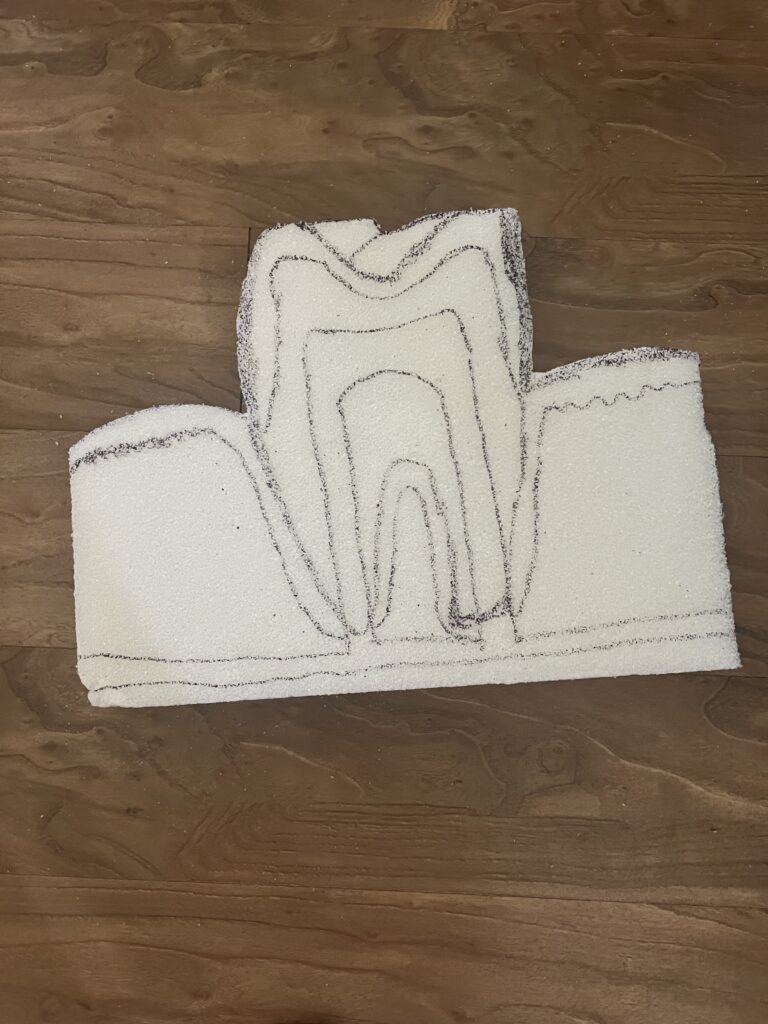

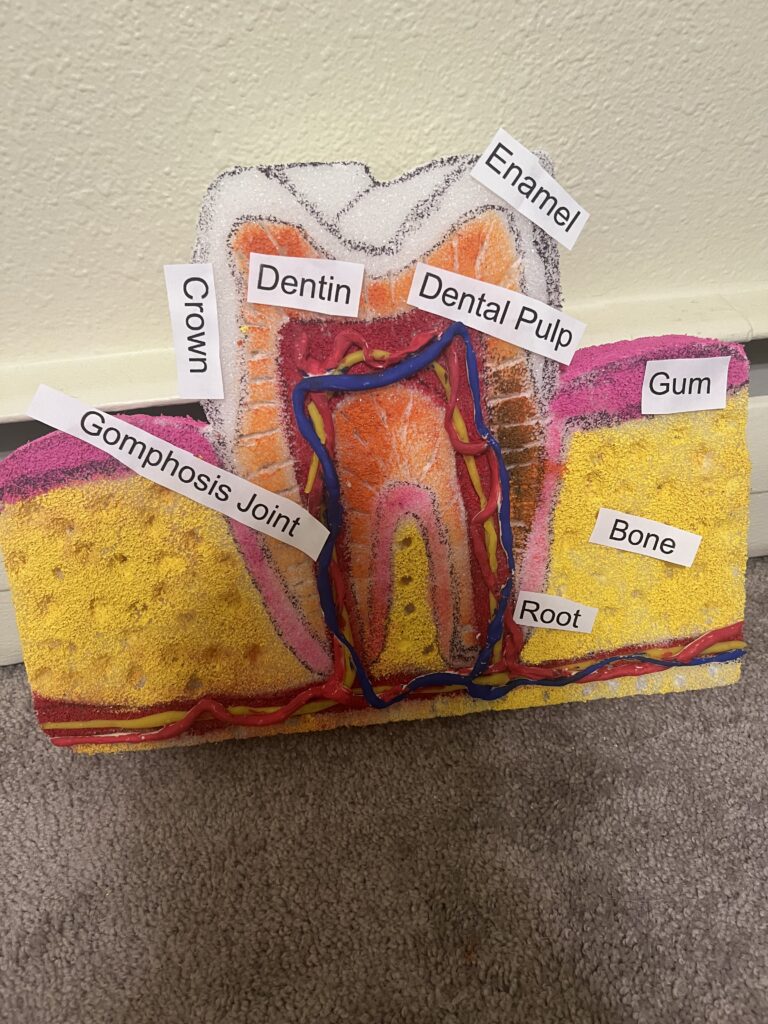
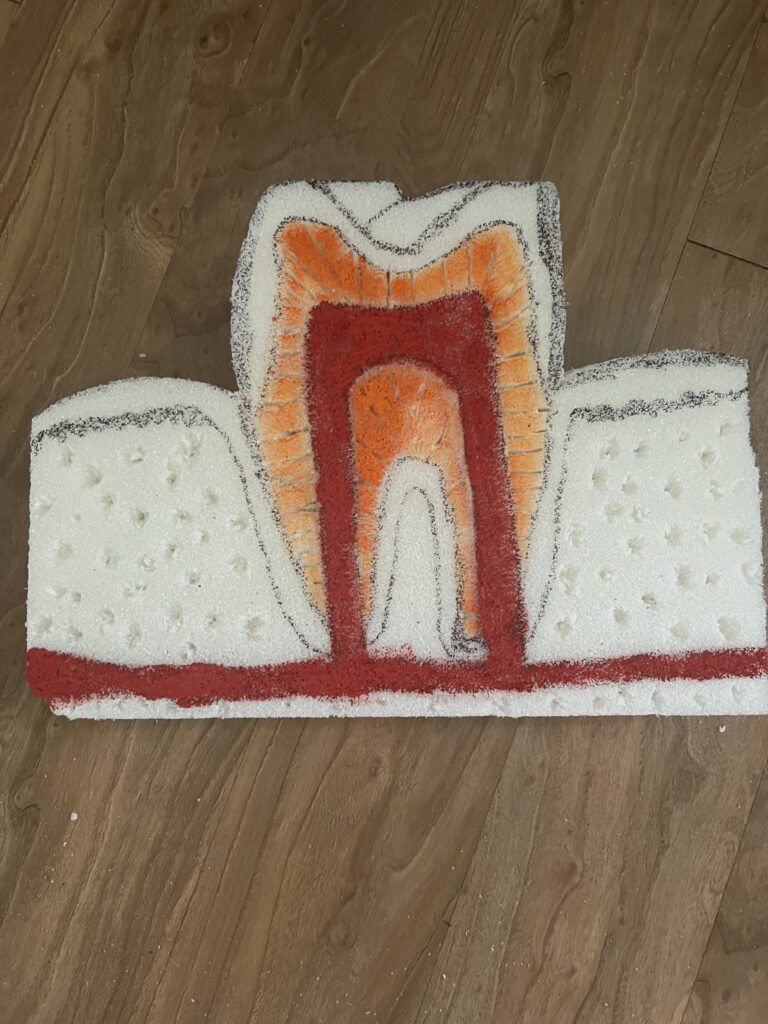
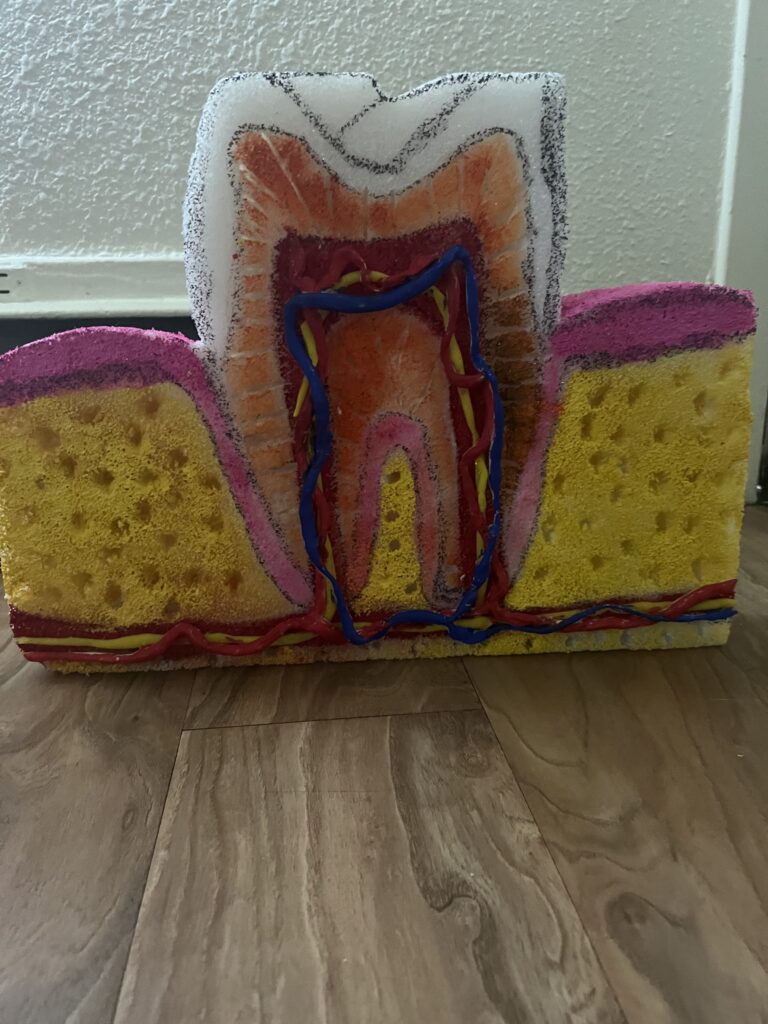
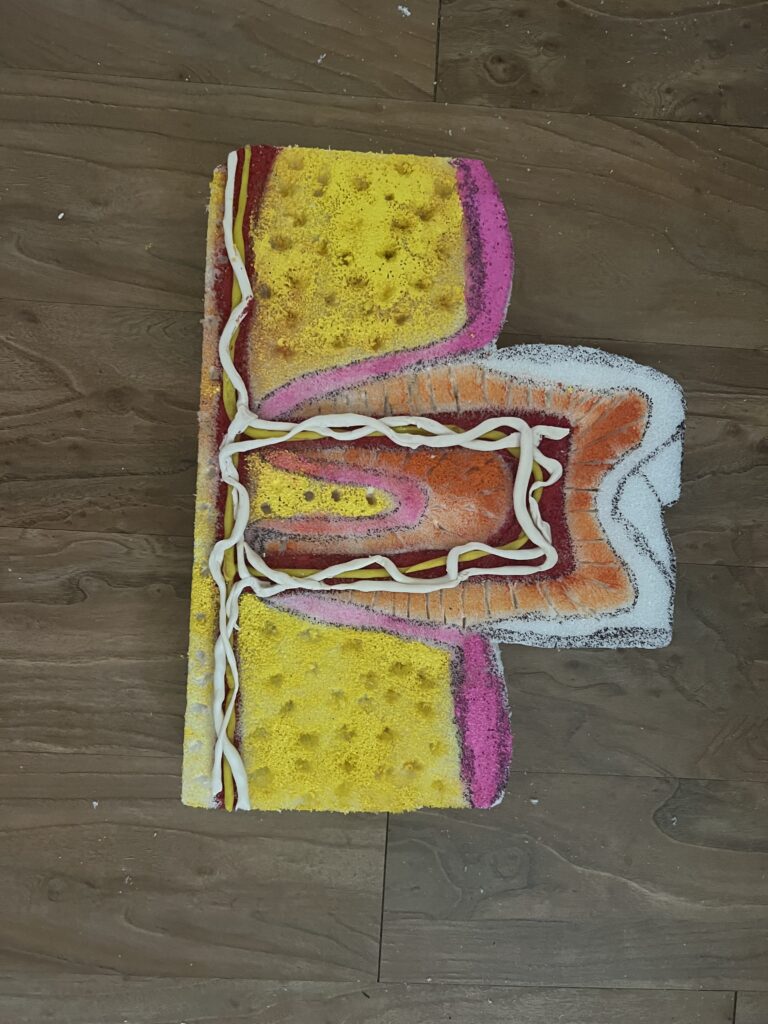
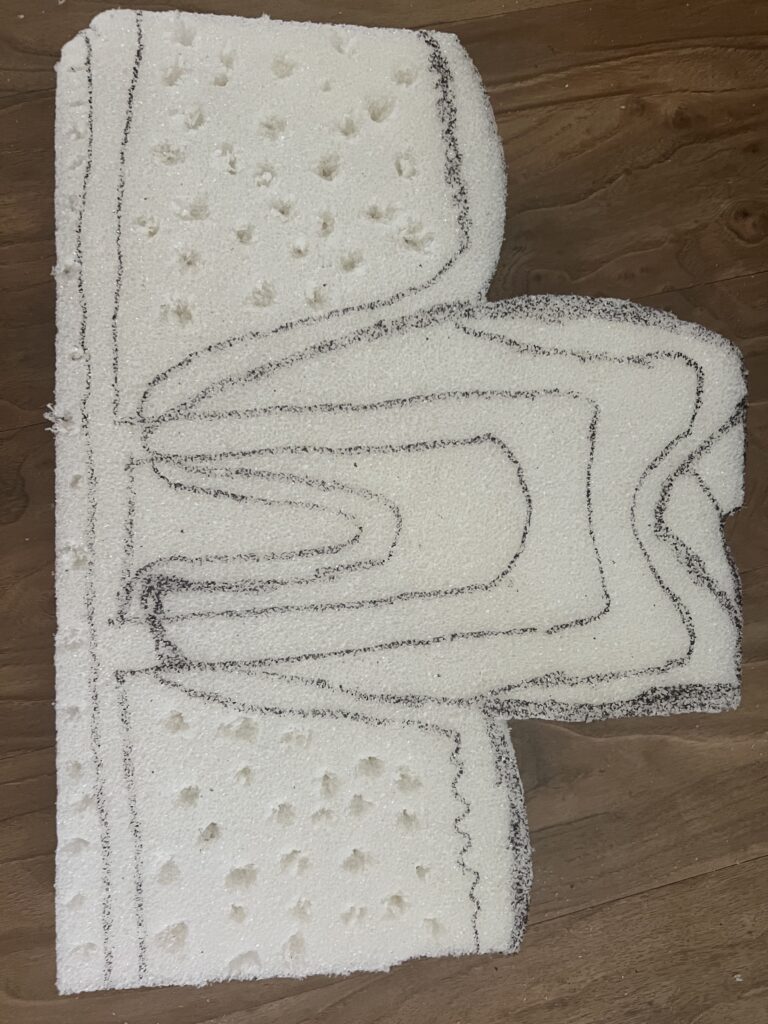
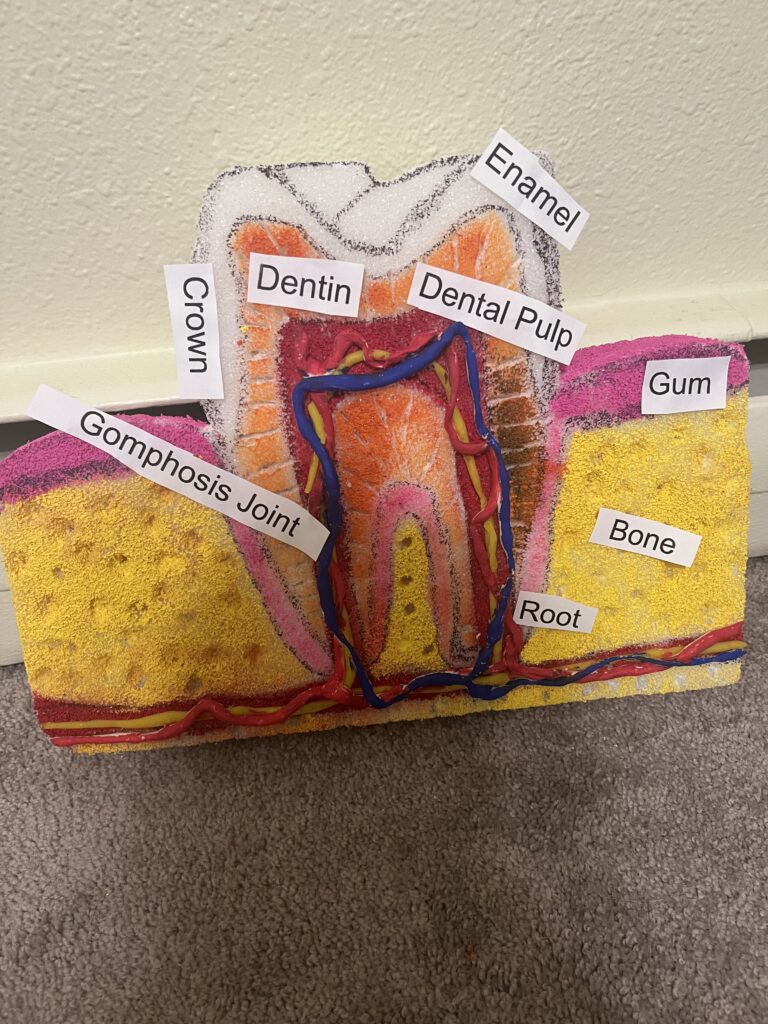

tooth and joint connection
Baylee’s STEAM project, The Tooth – Joint Connection aims to educate people on the different types of joints in the body and how it relates to the structure of a tooth. She does a great job explaining how the anatomy of the tooth relates to toothaches and common dental issues. In her visual representation of the tooth, the different structures are labeled clearly from the enamel down to the root. A tooth has multiple layers. The crown is the part of the tooth that is visible when you open your mouth, the enamel is the outer layer of the tooth that covers the crown, the dentin is below the enamel, and the pulp is below the dentin. In the essay, Baylee discusses the gomphosis joint that holds the tooth together in its socket. The joint itself doesn’t move and is supported by a layer of periodontal ligaments. She further explains that teeth have nerves inside them that are in the dental pulp. I also learned that the nerves in the temporomandibular joint are connected by a common pathway. The nerves in the dental pulp can sense pain, temperature changes, and pressure. When damage is done to the nerves, signals are sent to the brain and headaches can occur because it can spread to the jaw and increase headaches. The joint gomphoses helps protect the teeth but can be damaged and cause nerve problems and pain.